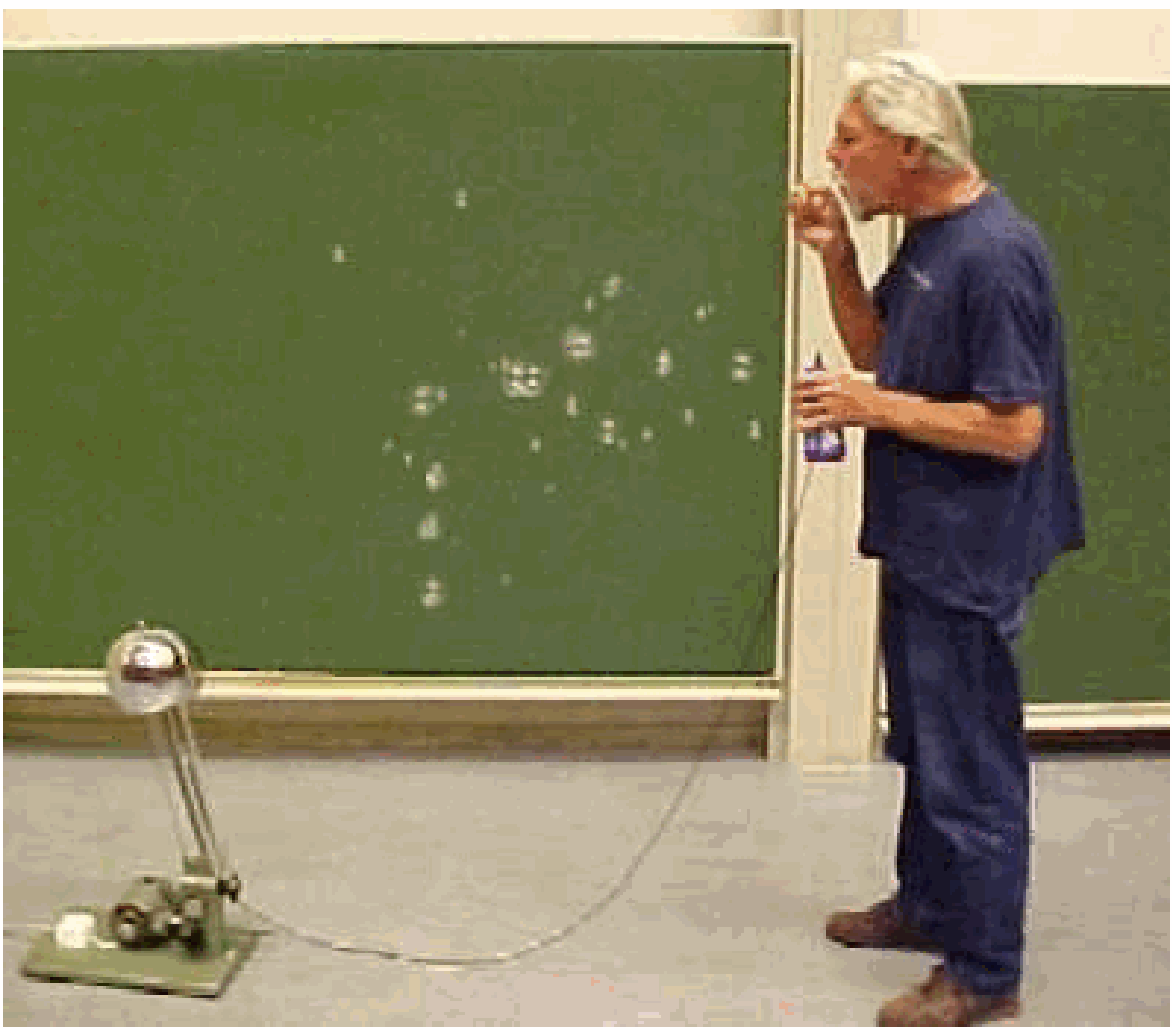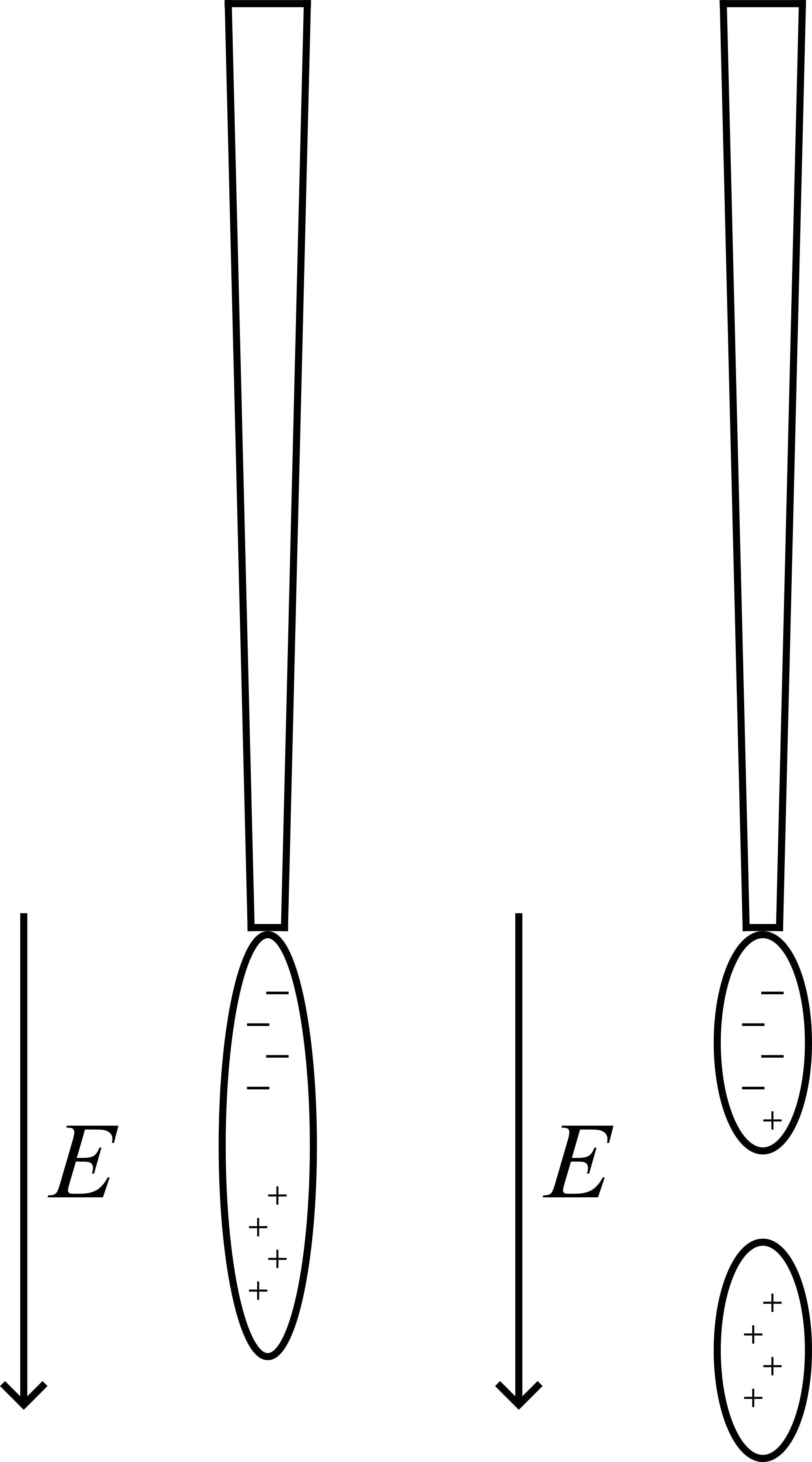01 Charge and Field; inside and-or outside?#
Aim#
To show that on a conductor the charge resides on the outside and that inside a charged conductor there is no field.
Subjects#
5B10 (Electric Fields) 5B20 (Gauss’ Law)
Diagram#

Fig. 455 .#
Equipment#
Metal pan on isolating piece of foam.
Two small conducting spheres.
Van de Graaff generator (see Safety).
Electroscope.
Grounded wire and grounded metal plate.
Safety#
In general working with a Van de Graaff generator is not considered as harmful. The Van de Graaff generator shown in the Diagram can produce voltages approaching \(270 \mathrm{kV}\) ( \(R_{\text {sphere }}=9 \mathrm{~cm}\) and supposing breakdown in air occurs at \(E=3 \times 10^{6} \mathrm{~V} / \mathrm{m}\) ), and yet at worst it delivers a brief sting. This device has a limited amount of stored energy, so the current produced is low and usually for a short time. During the discharge, this machine applies high voltage to the body for only a millionth of a second or less. In order to produce heart fibrillation, an electric power supply must produce a significant current in the heart muscle continuing for many milliseconds, and must deposit a total energy in the range of at least milli-joules or higher.
A critical remark added to this is the next letter that appeared in “Physics Today”, March 2010;
page 10 Physics students often try the fun experiment of holding a high-voltage pole while standing on an electrically isolating mat. The experiment is believed to be harmless, since no current is flowing. But the question can be raised, however, as to what happens to our skin. Air is an excellent supplier of charge, and it can be assumed that if our skin is at the same (positive) potential as the high-voltage generator, electrons will be attracted to the surface of our body. If the voltage supply is at tens of kilovolts, the energy with which electrons impinge on our skin can be as high as tens of kiloelectron volts. I wonder if anyone has ever studied the incidence of skin cancer in students who played with such an experiment for prolonged periods or, for that matter, in birds that rest on high-voltage cables. To be on the safe side, the experiment should be tested only briefly, if at all. (walter.margulis@acreo.se).
So, the message is: stay careful when working with a Van de Graaff generator.
Presentation#
Demo 1a#
Charge is brought on the outside of the pan by means shortly touching it with the wire that is connected to the Van der Graaff generator.
The demonstrator takes one of the small conducting spheres and touches with that sphere the inside of the pan (the audience can clearly hear that the inside is touched). The sphere is then made touching the electroscope that will show no deflection. Repeating the action will have no effect on the electroscope. Then the demonstrator repeats this action, but now he touches the outside of the pan with the metal sphere. Now the electroscope shows a deflection, which increases when he repeats his action.
Demo 1b#
The same demonstration is performed but now the metal pan is charged by touching the inside of the metal pan with the lead coming from the Van de Graaff generator. The result of this demo is exactly the same as in Demo 1a.

Fig. 456 .#
Demo 2#
The demonstrator holds the two metal spheres that are touching each other and lowers them into the pan. He takes care that the spheres do not to touch the inside of the pan. Inside the pan he separates the two spheres (see Figure 456B), lifts them out of the pan and with one of the spheres he touches the electroscope. The electroscope does not react. Also when he touches the electroscope with the other sphere nothing will happen.
He repeats the demonstration, but now he brings the two touching spheres close to the outside of the charged metal pan and there he separates the two spheres (see Figure 456A). Again he touches with one sphere the electroscope and now the electroscope shows a deflection. Next, he touches the electroscope with the other metal sphere and the deflection of the electroscope becomes less.
Explanation#
The first demonstration shows clearly that charge is always on the outside of the metal pan. Theoretically this can be explained when you apply Gauss’s law (see the demonstration Charge is on the outside
The second demonstration shows clearly that outside the pan there is an electric field that acts on the charges in the two neutral conducting spheres. These charges are separated from each other. And when, still in the field, the two spheres are separated, these charges are isolated. One sphere is positively charged now and the other negatively.
In the same way the demonstration shows that inside the metal pan there is no electric field.
Remarks#
Sometimes students experience Gauss’s law as the cause of phenomena. That’s why it is useful to stress that it is just the other way round: Nature behaves in such a way that there is no field inside the metal pan. This phenomenon is described best in the way Gauss formulated it.
Every time a new demonstration is done, discharge all components and yourself! To perform discharging, the grounded wire and grounded metal plate are used.
Take care that when the balls are close to the metal pan no sparks occur, because then the assembly of the two spheres is no longer neutral.
When in the electric field demonstration the two balls are not deep enough in the metal pan they will become charged a little when separated, showing that there exists a weak electric field near the opening of the metal pan.
Sources#
Wolfson, Richard, Essential University Physics, pag, 359-360
